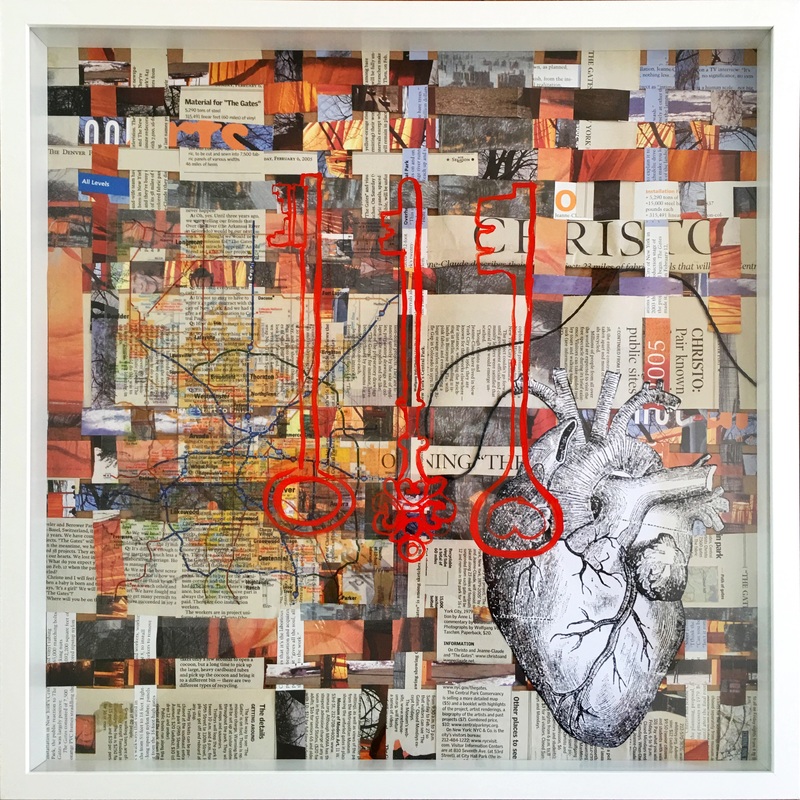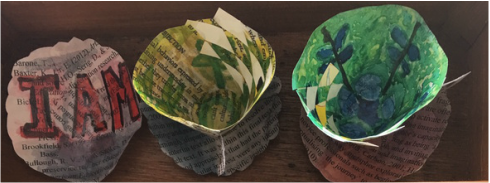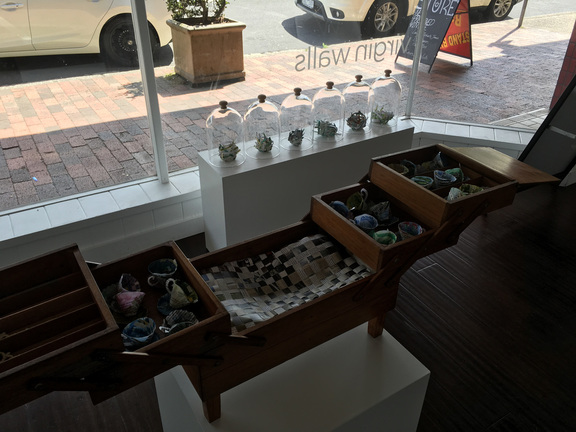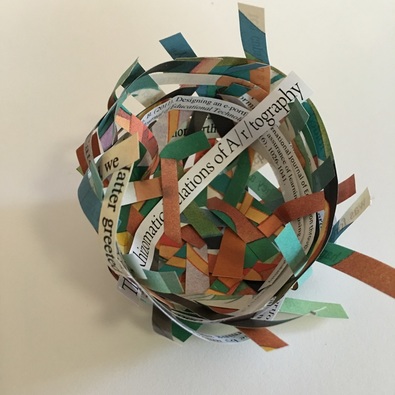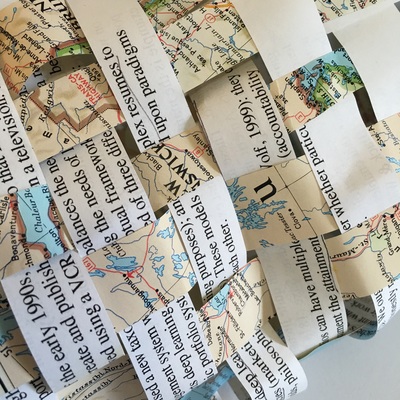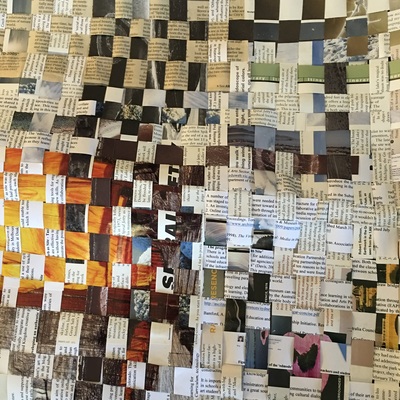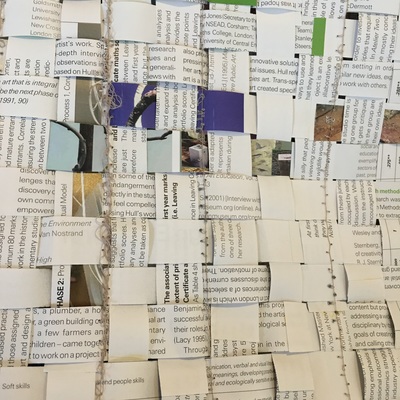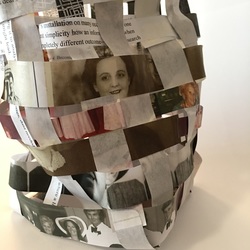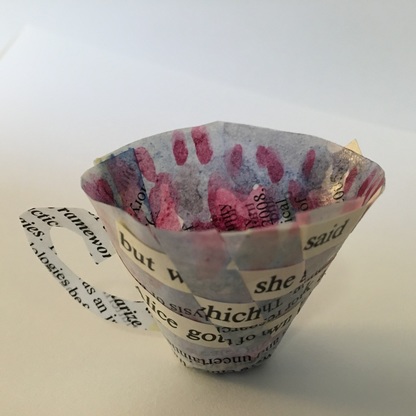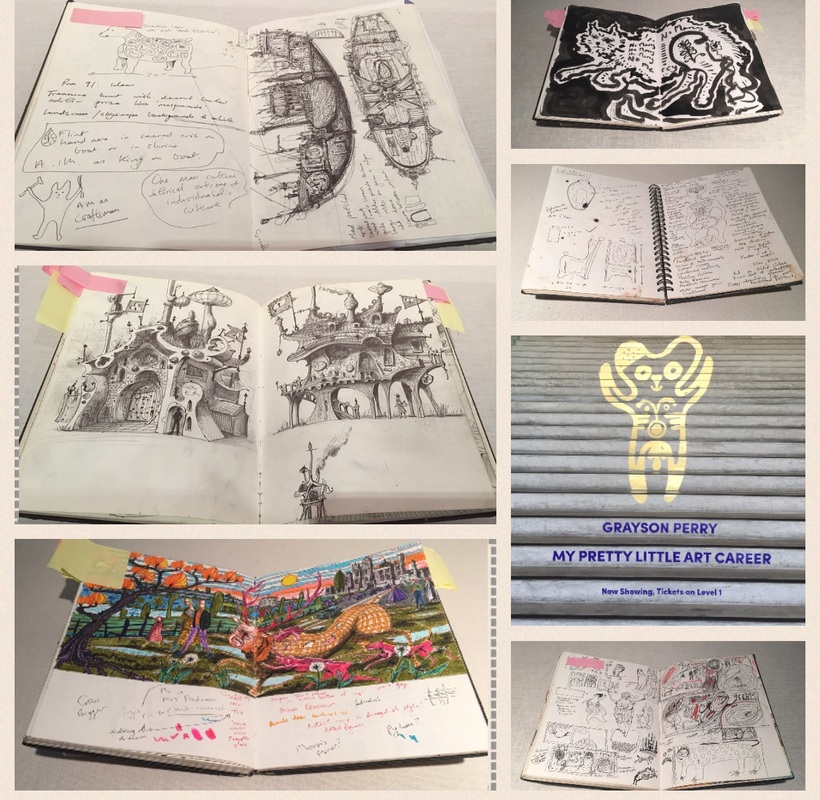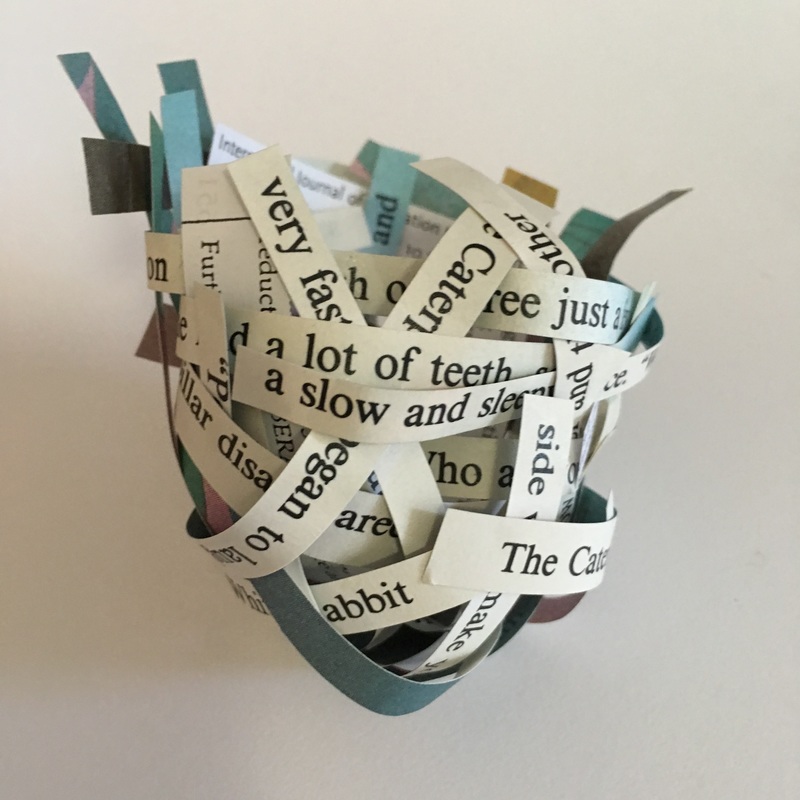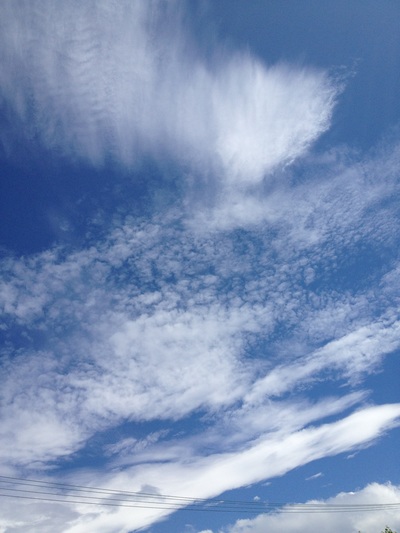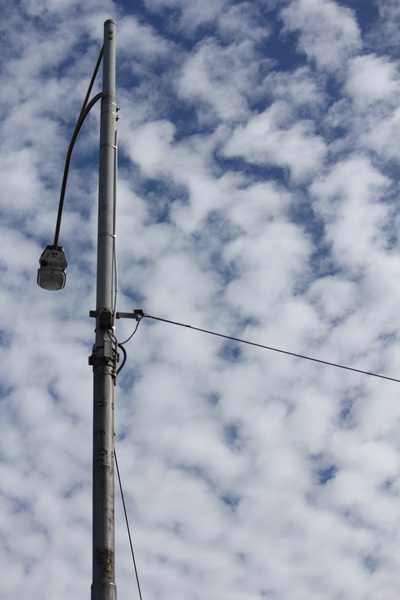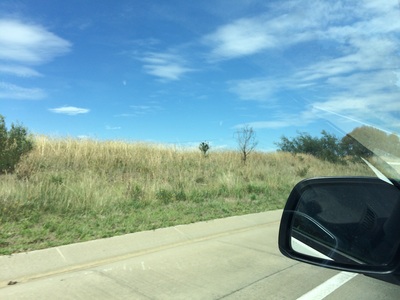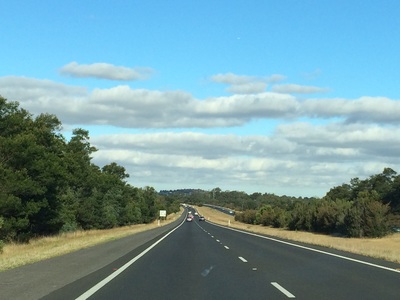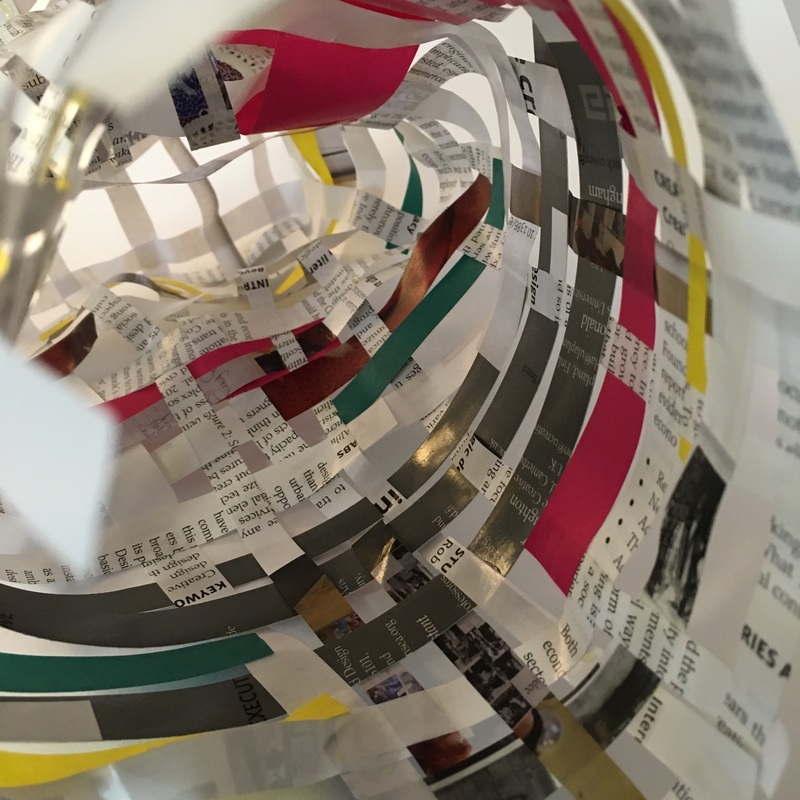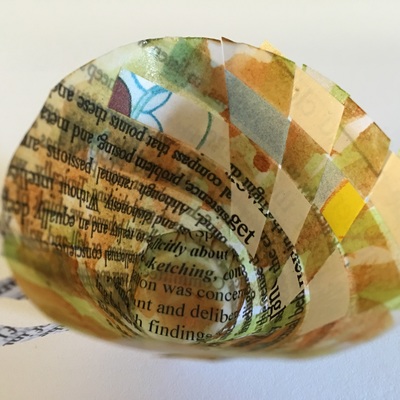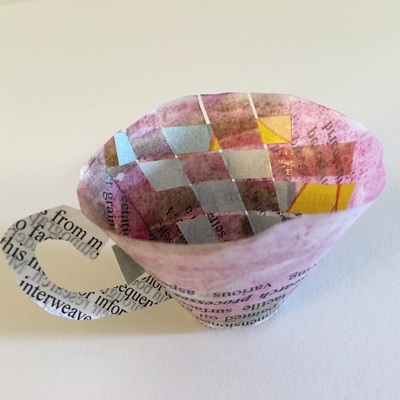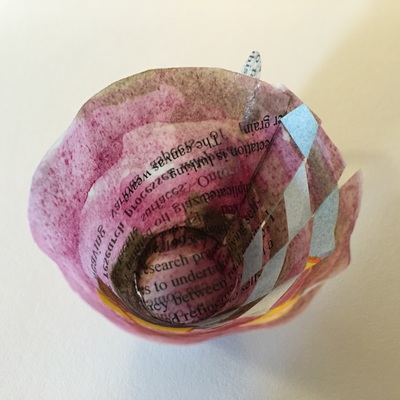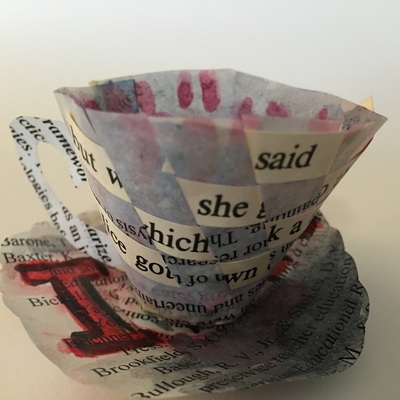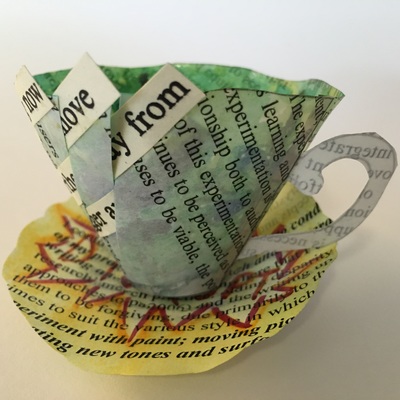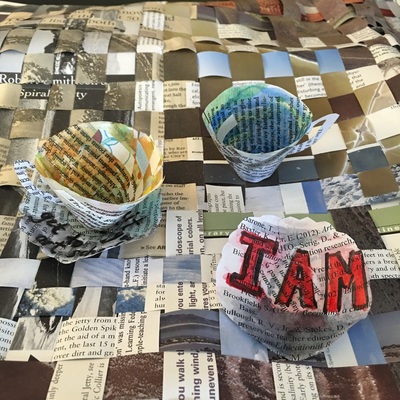Tea Cups from Conversations with the Seminals in Wonderland (The Researcher Tea Party) Folded & woven selection of academic papers/tea chest, 2014-2016
Contiguity
“Contiguity is a rendering that helps us to understand those ideas with a/r/tography that lie adjacent to one another, touch one another, or exist in the presence of one another” (Irwin & Springgay, 2008, p.xxviii).
The realisation of contiguity is an early epiphany or rendering of self within this inquiry. Contiguity is found not only in my intertwined identities that lie next to each other, but through the actions of the researcher, teacher and artist where the relationships between these three aspects of self blur the borders of the inquiry. This blurring or hazing happens between the inquiry, the questions and the self, between cites, sites and sights. The relationships between art and writing, between writing about art and writing about self. They are neatly folded as origami artefacts in this contiguity. “Contiguity is a rendering that helps us to understand those ideas with a/r/tography that lie adjacent to one another, touch one another, or exist in the presence of one another” (Irwin & Springgay, 2008, p.xxviii). This rendering is an important one to start this Portfolio with, for it directs this site and my sight. I am unable to unfold, to separate the a/r/t selves now that they exist as one.
|
As an arts based researcher and educator, I am interested in the role that self and identity play in research, art practice and art teaching. As a result, I have fixed myself in the centre of this a/r/tographic inquiry within the rhizome allowing me to gaze outwardly in sight of the research while “render[ing] research inquiries through artistic means” (Irwin, 2004, p.1). My research has been a living journey (Springgay, Irwin, Leggo & Gouzouasis, 2008; Springgay, Irwin & Wilson Kind, 2005) and is archived and exhibited here as a rhizomatic text, where image is research and a Portfolio is an art encounter. It is practiced and embodied, recorded and opened here. I call myself an a/r/tographer (Irwin, 2004). It is not a label or title, but a living methodological way of thinking, doing and theorising in art education “through an ongoing process of artmaking and writing while acknowledging one’s role as artist (a), researcher (r), teacher (t)” (Irwin, 2004, p.1). It represents praxis. “As arts based action researchers, they [a/r/tographers] propose that when teachers identify, reclaim and continually reframe their subjective understandings of teaching as social practice, they can embody a more responsible (Di Rezze, 2000; Surrey, 1991) disposition toward students; that is, be able to respond to them more thoughtfully, mindfully and with care” (Araujo, ND, para. 4). This was a shift in the early stages of this dissertation, where I had a sense of being, a turn to becoming.
|
Yesterday I was in a workshop on interdisciplinary research. The researchers were sharing their stories about funding opportunities and the possibilities of collaborations with researchers and practitioners from other disciplinary backgrounds. I sat reflecting on the words and ideas presented, considering my role as a/r/tographer in the room. What is it that I bring to this meeting? I am at once a disciplinarian, inter-disciplinary and multi-disciplinary researcher. As an a/r/tographer, it is possible to move in and out of spaces, cross paths and work with overlapping and woven ideas in a number of communities of practice. There are ruptures and junctures in the overlapping spaces, that offer opportunities for collaborations and community. These openings and gaps are the sites of epiphanies and possibilities for creativity. The liminal spaces are not only between art - research - teaching, they lie between the parallel tracks of inter and multi-disciplinary spaces. Between creativity, art education and digital pedagogies. As an artist, I work to bring these cross-hatched lines further together to create a place of unity through theorising in relational spaces. The workshop brought things into clarity for me, I saw my artworks created in the study as representations of the inbetween, of the liminal, spaces where I think all arts based researchers lie, often uncomfortably.
As Carter (2013) suggests, “the individual who seeks to bridge rather than divide the work of the artist, researcher and teacher by using a/r/tography (a form of arts-based research within educational research) to integrate and define simultaneously the distinctions of these three identities by dwelling in /’d or liminal spaces. A/r/tographers do not strictly adhere to traditional qualitative methodologies that state research questions and then seek to answer them explicitly. Rather, a/r/tographers use all aspects of qualitative research to allow them to theorize and learn as they go. This means that research is viewed as a continual evolving situated and active process that leads to deep learning (Irwin, 2010 in Kridel (Ed.))” (p.4).
|
|
|
Zahrah Habibullah
Encounters with Contiguity
It was the first time that I had taught outside of an art room. I had a 2 tier grey art trolley, filled with the media and materials required for my arts integration class, based on the lesson plan design that the coordinating subject teacher and I discussed and planned. I worked to a timetable that was created on a needs basis, across all years 9-12, across all subject areas. I traveled from classroom to classroom after filling my trolley with the materials and media that I may need. A decade later, some of my fondest memories I have of art teaching are based on this experience at Horizon High School in Denver, Colorado. The subject teacher and I co-taught the lesson content through experience or what Burnard, Craft, and Grainger et al (2006) coined “possibility thinking” through art making and studying. What I loved most about teaching arts integration, was seeing the potential of the visual arts to build and generate new knowledge, experiences and skills in other disciplines.
Outside of the art room; in the lab, the literature room and sport hall, I was teaching students to look at their disciplinary subject through the eyes and lens of an artist. One lesson that I still regard as one of my favourite moments in art teaching, was with a fantastic Science educator, Mr. Wayne Pound. I was invited by Wayne to teach watercolour to better understand cell structure. We did this together through the examination of cells in lenses under a microscope. Each student looked carefully at the colours, shapes and lines. We investigated how the colours created the shapes we were seeing. We examined and made notes about how the hues were darker around the edges, while Wayne defined and taught cell structure. As a high school student myself, I remember doing a similar activity. I was always lucky to have a pencil case filled with textas, crayons and coloured pencils but the learning activity, for me as a student to use colour and shape is not what I remember. I drew a ‘scientific’ sketch with a lead pencil into my science book. Wayne’s students with my assistance, were taught to see differently, to see the possibilities of cells, of colour, of artistry, through creative thinking. They looked as an artist would. They were being taught and guided to see and “think creatively,” “to make connections” and to consider “technique” (Tishman & Palley, 2010). We also learnt about the tooth of the watercolour paper, the kind of brushes that work best on this paper, the way that water can move watercolour paint and the way that with less water we can make the paint darker, more opaque. Together, in a science lab.
Outside of the art room; in the lab, the literature room and sport hall, I was teaching students to look at their disciplinary subject through the eyes and lens of an artist. One lesson that I still regard as one of my favourite moments in art teaching, was with a fantastic Science educator, Mr. Wayne Pound. I was invited by Wayne to teach watercolour to better understand cell structure. We did this together through the examination of cells in lenses under a microscope. Each student looked carefully at the colours, shapes and lines. We investigated how the colours created the shapes we were seeing. We examined and made notes about how the hues were darker around the edges, while Wayne defined and taught cell structure. As a high school student myself, I remember doing a similar activity. I was always lucky to have a pencil case filled with textas, crayons and coloured pencils but the learning activity, for me as a student to use colour and shape is not what I remember. I drew a ‘scientific’ sketch with a lead pencil into my science book. Wayne’s students with my assistance, were taught to see differently, to see the possibilities of cells, of colour, of artistry, through creative thinking. They looked as an artist would. They were being taught and guided to see and “think creatively,” “to make connections” and to consider “technique” (Tishman & Palley, 2010). We also learnt about the tooth of the watercolour paper, the kind of brushes that work best on this paper, the way that water can move watercolour paint and the way that with less water we can make the paint darker, more opaque. Together, in a science lab.
My experience of arts integration (Silverstein & Layne, 2010) at Horizon High was as Eisner referred, a cultural bridge. As arts integration coordinator, I was responsible for building bridges of creativity between art and other disciplinary spaces, between the artist self and teacher self, and an encounter with contiguity as embodiment. “Arts based learning illuminates gaps and limitation in current ideas and helps students to organize frameworks and structures through which they can test limits and develop new structures that bridge the gaps between that which is known and that which will be created (Eisner, 1972)” (in Smilan, Torres de Eça, Kakourou-Chroni & Reis, N.D, p.2). This bridge brought arts based learning into a new world of learning, integrated and transformative for me as art based researcher and educator and for my students to learn in the creative gaps found between the disciplines. “Arts integration provides multiple ways for students to make sense of what they learn (construct understanding) and make their learning visible (demonstrate knowledge and understanding). It goes beyond the initial step of helping students learn and recall information to challenging students to take the information and facts they have learned and do something with them to build deeper understanding” (Silverstein & Layne, 2010, p.3). The spaces we made visible through integration were transformative and were the first times I had been involved in bringing my world of knowing and doing to another. “Arts integration is an approach to teaching in which students construct and demonstrate understanding through an art form. Students engage in a creative process which connects an art form and another subject area and meets evolving objectives in both” (Silverstein & Layne, 2010, p.1). Eisner believed that "art has to function in students lives, outside of the context of schooling, and teachers make this happen by creating bridges between what they are studying in school and the life that they're going to be leading outside of school" (Eisner, in Tishman & Palley, 2010, p.13). As Wiebe, Sameshina, Irwin, Leggo, Gouzouasis & Grauer (2007) suggest, “when teachers understand themselves as a/r/tographers, they are better positioned to integrate the arts into the curriculum” (p.274). A/r/tography was not a methodology I understood at the time, however this turn was significant and a further turn to an embodied understanding of praxis. However, upon reflection of these experiences, I was teaching, researching and making through this contiguity of selves. I was drawing on an embodied understanding of practice as a/r/tographer.
|
|
As Zahrah so perfectly shares here, 'art is part of me' and one of the aspects of my undergraduate university experience that I enjoyed most, was the ability to see my educators as creative practitioners, seeing them work in a shared art making studio environment, talk about art and share their theorising of inquiries through the nexus of teaching and research (Bennett, Wright, & Blom, 2010). I tried to mirror this in my secondary classroom and now have the privilege to do this in my current role through the explicit teaching of creativity in art education through research, art practice and pedagogy. Csiksentmihalyi (1996) believes that the best environment for creative practice is a social one and “creativity should be ultimately linked to social contexts, and be understood by the interaction processes” (Kuo, 2011, p.67). As Hsu-Chan Kuo furthers, “some investigators such as Csikszentmihalyi (1988; 1996; 1998; 2000), Amabile (1983; 1996), and Sternberg and Lubart (1991; 1995) therefore advocate the study of creativity in the social context. According to the scholars above, regardless of whether creativity is considered as personal traits, creative behaviour, a cognitive process, or either something that can be trained, creativity should be ultimately linked to social contexts, and be understood by the interaction processes” (2011, p.67). My art education as a student, educator and researcher was creatively rich. Visual arts education has allowed me to continue in and with this creativity while being ‘inquisitive, persistent, imaginative, disciplined and collaborative’ (Lucas & Claxton, 2012) throughout my career. As a/r/tographer, I choose to assemble and collage these encounters, experiences, memories and accounts. This becoming has been made possible through the layering of these roles, responsibilities, and selves through a deeper understanding of contiguity. Contiguity invites creativity through thinking, making and creating ideas then pushing the boundaries of self and knowledge beyond the borders where the ideas lie adjacent to one another.
"I have always been an Artist" Pamela Griffith
Our stories are who we are (Ellis & Bochner, 2000).
My story is an overlapping, connected and intertwined story, found in contiguity between images and text in a digital space. Here my story is focused and re-framed to open the possibilities for digital pedagogy and portfolios in art education for creativity. As artist-researcher-teacher, I see new opportunities for creativity through an understanding of contiguity for artist-students to see how art teaches the skills to see and notice, while thinking differently through reflection for self discovery. The first is a turn to artist-student, a contiguous relationship that invites a shift in identity for the learner. An invitation and cultural bridge between the learner of art and the learner as artist. We too often do not invite our learners to participate as artist, through artful inquiry, rather creating opportunities for 'doing' art. My opening, is to invite deep and sustained art making practice that creates the climate for flow and creativity in our studies of art that are then curated in digital portfolios through an ongoing reflection and collection of making and writing as artist for an audience. Mapping this storied journey with art as artist and as art audience inside a curated portfolio is the opening where I see a turn for art education. My A/R/T Portfolio designed and curated here, maps my contiguous identities, relationships, roles and explorations in art education through my sight and site. It is curated as a living digital currere for art educators to invite their secondary art students to explore their own identities and learn to notice and see the common threads of their creative practice, informed and framed by reflection and creativity in a contiguous site - a digital portfolio. A contiguous site that is situated, yet digital. Invisible, yet visible. An encounter with the self and with art.
“For the rupturing encounter also contains a moment of affirmation, the affirmation of a new world, in fact a way of seeing and thinking this world differently. This is the creative moment of the encounter that obliges us to think otherwise. Life, when it truly is lived, is a history of these encounters, which will always necessarily occur beyond representation” (O’Sullivan, 2006, p.1).
“For the rupturing encounter also contains a moment of affirmation, the affirmation of a new world, in fact a way of seeing and thinking this world differently. This is the creative moment of the encounter that obliges us to think otherwise. Life, when it truly is lived, is a history of these encounters, which will always necessarily occur beyond representation” (O’Sullivan, 2006, p.1).
Gallery sitting, Blackheath, NSW March 24, 2016
I met a glass artist on my first day here. We talked about the importance of community, of relationality and of collaboration in art. We discussed his work, his search for a sense of self throughout his practice and our common threads. He came back the following day and shared his life journey with me, we talked more about my pedagogical philosophies of teaching identity formation in secondary art education. As an older artist, he shared with me how important validation was for him as an early art maker and that he still was always striving for some kind of verification that he is ‘artist’. He came back today and said thank you for my validation.
I knew that curating my artist-researcher-teacher self would invoke new dialogue. I was not really ready for the narratives it would begin with others about their lives. Each time I say hello and define my work as a/r/tographer for a visitor, it begins a new way each time. It also ends in a new way too. These reflective conversations in the curated gallery space invite new ways of thinking and exploring a/r/tography. It is here through a critical autoethnographic gaze that I am able to stare inwards, now as an insider to see what I have been able to achieve, to have invited new discourse into what it means to be an a/r/tographer.
I met a glass artist on my first day here. We talked about the importance of community, of relationality and of collaboration in art. We discussed his work, his search for a sense of self throughout his practice and our common threads. He came back the following day and shared his life journey with me, we talked more about my pedagogical philosophies of teaching identity formation in secondary art education. As an older artist, he shared with me how important validation was for him as an early art maker and that he still was always striving for some kind of verification that he is ‘artist’. He came back today and said thank you for my validation.
I knew that curating my artist-researcher-teacher self would invoke new dialogue. I was not really ready for the narratives it would begin with others about their lives. Each time I say hello and define my work as a/r/tographer for a visitor, it begins a new way each time. It also ends in a new way too. These reflective conversations in the curated gallery space invite new ways of thinking and exploring a/r/tography. It is here through a critical autoethnographic gaze that I am able to stare inwards, now as an insider to see what I have been able to achieve, to have invited new discourse into what it means to be an a/r/tographer.
The spaces, overlaps and reverberations that the renderings as lenses of learning offer, are insightful and need to be explored further for resonance. Many qualitative researchers discuss ‘aha!’ (Maple & Edwards, 2009) or ‘epiphany’ moments (Adams, Holman Jones & Ellis, 2015; Trahar, 2009). Many of these are “remarkable and life changing experiences that transform us and call us to question” (Adams, Holman Jones & Ellis, 2015, p.26) ourselves, through the sharing of lives, stories and encounters, but also in meeting and talking with some of the seminal thinkers in my fields of research. As I designed and developed my research project for this study, to explore the potential of artist portfolios in developing self and practice in art education, I have explored many fields of inquiry. Walking, running, pacing and laying amongst some of the seminal voices in my inter and multi-disciplinary fields of inquiry.
I have developed strong bonds with the voices and echoes of creativity, identity, digital pedagogies and art education. I went out to my communities to gather insider knowledge and to encounter the insider experiences. As many autoethnographic explorers find, the projects many of us design are grounded in our personal experiences, and grounded in our life stories. My identity is woven in and through this study and here in this A/R/T Portfolio I perform this contiguity and offer a space to learn in and from experience in the liminal spaces of art, of research and of teaching. “Some autoethnographers discuss their experiences with identity” (Adams, Holman Jones & Ellis, 2015, p.26). This Portfolio is an exhibition of these experiences with a creative identity. An exploration of my identity as artist, researcher and teacher, mapped and cartographically drawn to explore and investigate the opportunities of portfolios for learning in art education through my experiences as a/r/tographer. “When one is first confronted with what it means to be an a/r/tographer or to work a/r/tographically I feel that there is a process of understanding, questioning and inquiring that takes place in order to fully comprehend and embrace this way of being” (Carter, 2013, p.2).
“To live the life of an a/r/tographer is to live a contiguous life sensitive to each of these relationships and particularly to the spaces in-between” (Irwin & Springgay, 2008, p.xxviii). Flood (2013) calls these spaces ‘gaps’: “the zone between delineated areas of knowledge” (p.213). She asks us to consider, how as creative practitioners, through creative teaching, that we help to find these gaps for our students and to offer opportunities for the gaps to be found in our learning design and classrooms. I believe that we can work in the gaps, the spaces in-between when we collect, reflect, and select artefacts that represent our identities and then curate them to display and exhibit our journeys in personalised spaces. This pedagogy and philosophy of portfolios differs from the portfolios or artist diaries we think of for artists and art education. It is a new way to build on this knowledge and display, exhibit and curate bodies of work for an audience, but also a way to develop an understanding of the self as artist, the self as explorer and record, archive and document this way of being and seeing. The new world of the digital has enabled this shift, the digital turn opens the space for possibilities to render new understanding and create new opportunities to encounter art.
I have developed strong bonds with the voices and echoes of creativity, identity, digital pedagogies and art education. I went out to my communities to gather insider knowledge and to encounter the insider experiences. As many autoethnographic explorers find, the projects many of us design are grounded in our personal experiences, and grounded in our life stories. My identity is woven in and through this study and here in this A/R/T Portfolio I perform this contiguity and offer a space to learn in and from experience in the liminal spaces of art, of research and of teaching. “Some autoethnographers discuss their experiences with identity” (Adams, Holman Jones & Ellis, 2015, p.26). This Portfolio is an exhibition of these experiences with a creative identity. An exploration of my identity as artist, researcher and teacher, mapped and cartographically drawn to explore and investigate the opportunities of portfolios for learning in art education through my experiences as a/r/tographer. “When one is first confronted with what it means to be an a/r/tographer or to work a/r/tographically I feel that there is a process of understanding, questioning and inquiring that takes place in order to fully comprehend and embrace this way of being” (Carter, 2013, p.2).
“To live the life of an a/r/tographer is to live a contiguous life sensitive to each of these relationships and particularly to the spaces in-between” (Irwin & Springgay, 2008, p.xxviii). Flood (2013) calls these spaces ‘gaps’: “the zone between delineated areas of knowledge” (p.213). She asks us to consider, how as creative practitioners, through creative teaching, that we help to find these gaps for our students and to offer opportunities for the gaps to be found in our learning design and classrooms. I believe that we can work in the gaps, the spaces in-between when we collect, reflect, and select artefacts that represent our identities and then curate them to display and exhibit our journeys in personalised spaces. This pedagogy and philosophy of portfolios differs from the portfolios or artist diaries we think of for artists and art education. It is a new way to build on this knowledge and display, exhibit and curate bodies of work for an audience, but also a way to develop an understanding of the self as artist, the self as explorer and record, archive and document this way of being and seeing. The new world of the digital has enabled this shift, the digital turn opens the space for possibilities to render new understanding and create new opportunities to encounter art.
Encounters with self as artist
There seems to be a disparity between artist and art maker. It seems to only exist in certain pockets of art, where some art seems to be more artful or more technically difficult, be made by someone others call artist or held back until one has had a sell out show. My conversations with the co-participants of the study included a prompt about self as artist. I wanted to better understand the path of artist to support developing and designing portfolios for artist-students. Claiming who you are is an important aspect of a curated exhibition, it sets the scene for the world that you are to step into. "To be able to believe: 'I am creative', authentically engaging with what creativity means for professional and personal practice, is a threshold that both learners and teachers will encounter in teaching and learning for creativity" (Allen, 2015, p. 15). When others curate shows, the world and scene designed and created by the curator, the narrative and story is told by an outsider, they construct the space through placemaking devices to invite you in. There is wall text, show titles, initial works are selected to sway your emotional attachment to the exhibition and create an opening for you. In a digital portfolio as exhibition of the self as artist, curated by the self, 'artist' must be claimed. The digital portfolio designer needs to state this is my space, curated here for you to weave your way through my site. Identity and self discovery are important aspects of self as artist. Teaching artistry through artful inquiry and artist as maker is a turn in art education.
|
|
|
Encounters with Portfolios
Much of the research into ePortfolios indicate that the development of a portfolio for learning (Batson, 2010; Barrett, 2005) and assessment of learning (Klenowski, Askew & Carnell, 2006; Krause, 2006; Mason, Pegler & Weller, 2004) supports student reflection (Holland, 2015), aids in developing habits of mind (Peet, 2012) and metacognitive knowledge (Wozniak & Zagal, 2013). They are a powerful pedagogy that provide a space for personalised learning, learning centred learning and the student as the centre of the inquiry. Many portfolio studies report that they are both a tool and a pedagogy (Yancey, 1992), while the literature tells us that portfolios support a lifewide and lifelong approach to collecting, selecting and presenting artefacts (Barrett, 2005) for a range of audiences in different contexts throughout a learner’s journey.
As an artist I have a variety of physical and digital folios of work for a range of purposes and audiences that I have had since childhood. My portfolio spaces allow me to articulate who I am while being able to invite discourse and reflection on process, product and practice through my design, planning and curation. This Portfolio is a curated site of this embodied praxis. The curation of my identity artefacts in this story are drawn together with threads that I have woven intentionally to develop the material connections between the artefacts. My knowledge, skills, experiences, education and creativity underpin this intent in curation. I have made careful and considered decisions about the way that my art making, video, narrative and writing are composed. How the artefacts have both an aesthetic affect and creative affect. Looking through this lens of curation and digital storytelling in portfolios enables a shift in thinking for art educators to use our exhibition language of curation (Coleman, 2015) as well as storytelling that runs through our discourse as a device to construct new knowledge and creative practice in our classrooms to enable personalised learning (Batson, 2016).
I have always made art. Whether it was a craft activity, colouring in or busy work at primary school, I made it my artwork. I was able to see how my creative understanding of media, materials and subject matter could be developed into something that represented how I felt, aesthetically and conceptually responding to the world at the time. I always knew that I would work in the art world and be an artist, be an artist-teacher and live with art in my life. I wanted to bring this knowledge of art to others.
My first portfolios are in paper scrapbooks, where my mum curated my early encounters with art in chronological order through carefully glued drawings and paintings, collated and curated to tell my first stories as artist and creative. These portfolio stories are full of memories; they invoke nostalgia and at the same time seem to determine the path that I followed. The stories each of the images tell are personal, reflective and emotive. What we know from Vasari and other printed curated collections and monographs of the lives of artist, is based upon the author’s personal responses to the works created. The shift that I seek in art education is to support the early artist-student themselves to become the curator of their artistry, reflecting on their work iteratively over time in a digital portfolio. For the artist-student to make decisions about how their work is displayed, what dialogue it has with the works around it and how a story is told to a digital audience. This digital turn, creative turn and personalised turn is an opening to understanding the contiguity of art, to show why art matters in schools and to bring an artful inquiry to our learners that will have ramifications for learning beyond the walls of our art studios.
As an artist I have a variety of physical and digital folios of work for a range of purposes and audiences that I have had since childhood. My portfolio spaces allow me to articulate who I am while being able to invite discourse and reflection on process, product and practice through my design, planning and curation. This Portfolio is a curated site of this embodied praxis. The curation of my identity artefacts in this story are drawn together with threads that I have woven intentionally to develop the material connections between the artefacts. My knowledge, skills, experiences, education and creativity underpin this intent in curation. I have made careful and considered decisions about the way that my art making, video, narrative and writing are composed. How the artefacts have both an aesthetic affect and creative affect. Looking through this lens of curation and digital storytelling in portfolios enables a shift in thinking for art educators to use our exhibition language of curation (Coleman, 2015) as well as storytelling that runs through our discourse as a device to construct new knowledge and creative practice in our classrooms to enable personalised learning (Batson, 2016).
I have always made art. Whether it was a craft activity, colouring in or busy work at primary school, I made it my artwork. I was able to see how my creative understanding of media, materials and subject matter could be developed into something that represented how I felt, aesthetically and conceptually responding to the world at the time. I always knew that I would work in the art world and be an artist, be an artist-teacher and live with art in my life. I wanted to bring this knowledge of art to others.
My first portfolios are in paper scrapbooks, where my mum curated my early encounters with art in chronological order through carefully glued drawings and paintings, collated and curated to tell my first stories as artist and creative. These portfolio stories are full of memories; they invoke nostalgia and at the same time seem to determine the path that I followed. The stories each of the images tell are personal, reflective and emotive. What we know from Vasari and other printed curated collections and monographs of the lives of artist, is based upon the author’s personal responses to the works created. The shift that I seek in art education is to support the early artist-student themselves to become the curator of their artistry, reflecting on their work iteratively over time in a digital portfolio. For the artist-student to make decisions about how their work is displayed, what dialogue it has with the works around it and how a story is told to a digital audience. This digital turn, creative turn and personalised turn is an opening to understanding the contiguity of art, to show why art matters in schools and to bring an artful inquiry to our learners that will have ramifications for learning beyond the walls of our art studios.
I carried a cardboard portfolio for 6 years of high school on the bus.
It held my thoughts, hopes, dreams, ideas, finished drawings and paintings.
Then I went to art school.
I remember carrying the biggest folio I ever had to the interview.
It was scary and exciting to show the leaders of my art world what I knew how to do.
I remember standing on the highway with my portfolio under my arm like a sail.
I hung tight in the wind as I dodged the traffic.
I always carried my portfolio proudly under my arm.
It was a sign to everyone that I passed by that I went to art school.
|
|
In high school, I was taught by my year seven art teacher how to make a cardboard portfolio, it was created from two large cardboard sheets and had holes cut out for my carrying and duct tape to keep the sheets together. It was tied on each end with string and housed all of my work; ideas, cut outs, sketches and media explorations. In my later years of high school with a syllabus change, we received hard bound black covered art books called “Visual Art Process Diaries” or VAPD’s as they were fondly called by our teachers. I loved this idea of designing and collating my learning and having the opportunity to look back at my work over the year. I understood its value in my learning as an artist to see my process in one place and I was drawn to developing ideas in these visual diaries. One big change was assessment. We now had to submit these bound books for marking by our teachers, these process oriented portfolios had become products. As a teacher I also had to assess these diaries and mark the process of my students’ creative practice. This shift seemed ever so slight for me as a student, but now upon reflection it was a major turn in assessing artistic practice. In this process of remembering, I am further drawn to Teresa Amabile’s ‘The Components of Creativity’ (1996). Is the ability to see the progress, touch, see and smell art making as it develops aid in an understanding of creativity? Or can we do this digitally through digital portfolios?
Portfolio thinking and learning is not very natural. We reflexively think through our actions as artists and makers, stopping to photograph the product, often not spending much time to record our reflections, and very few of us then record and archive these reflections over time. We have much to learn from those artists that have built this into their practice. Many artists use a visual diary to record ideas, it is a space for ideation and exploration. We take our ideas for a walk, often returning to them for inspiration or guidance as we work on a piece or collection of works. This process is process oriented, it is for us as artists to collect our thoughts in. In art education, we have this process oriented visual diary as a component of many of our syllabus. We want to see how a student developed their ideas from process to product, how they conceived of the ideas and then resolved their practice. My turn to the digital portfolio takes this a step further, asking the artist-student to consider the final work as part of the journey, and to present a curated portfolio that indicates the how and why, to develop a deeper embodied understanding of being with creativity through sustained deep personalised learning. To gaze inwardly on the self to understand what you have made and why you have made it, as artist.
By creating gaps in the learning for art students to reflect on creative practice, they have the opportunity to learn about themselves through reflection on and in creative practice. Here in this contiguity, of artist and curator lie the opportunities for the rhizomatic digital portfolio, creating openings and opportunities for learning through the eyes of a museum curator.
Portfolio thinking and learning is not very natural. We reflexively think through our actions as artists and makers, stopping to photograph the product, often not spending much time to record our reflections, and very few of us then record and archive these reflections over time. We have much to learn from those artists that have built this into their practice. Many artists use a visual diary to record ideas, it is a space for ideation and exploration. We take our ideas for a walk, often returning to them for inspiration or guidance as we work on a piece or collection of works. This process is process oriented, it is for us as artists to collect our thoughts in. In art education, we have this process oriented visual diary as a component of many of our syllabus. We want to see how a student developed their ideas from process to product, how they conceived of the ideas and then resolved their practice. My turn to the digital portfolio takes this a step further, asking the artist-student to consider the final work as part of the journey, and to present a curated portfolio that indicates the how and why, to develop a deeper embodied understanding of being with creativity through sustained deep personalised learning. To gaze inwardly on the self to understand what you have made and why you have made it, as artist.
By creating gaps in the learning for art students to reflect on creative practice, they have the opportunity to learn about themselves through reflection on and in creative practice. Here in this contiguity, of artist and curator lie the opportunities for the rhizomatic digital portfolio, creating openings and opportunities for learning through the eyes of a museum curator.
It was one of the hot, hot Sydney December days when you sweat from parts of your body that you didn’t know could sweat. I used to teach out in Sydney’s western suburbs, where the sweat runs into your eyes and stings while you’re trying to teach, I know these hot days well. On one of those days, I had left it late getting into the city to experience all that I had to in an opportunity of an a/r/tographer’s lifetime. I jumped off the train and ran from the Quay to the Opera House to pick up my ticket. It was hot, there were tourists lingering and sipping water, or licking gelato by the harbour. I was on my way to see one of my artist heroines, Grayson Perry. Grayson’s presentation was titled, How to be an ‘Artist Just Like Me’, followed by a conversation with Museum of Contemporary Art (MCA) chief curator Rachel Kent about Perry's first major Australian blockbuster, ‘My pretty little art career’. Perry's presentation was one one of the many 'openings' that were offered to me on a platter, by the art gods throughout this study. I made it the Opera House, that hot afternoon, I was on the edge of my seat, laughing, crying and totally enthralled by Grayson Perry’s art story. S/he was raw, funny, open and allowed us into an artist and artful life through a ten-point visual essay, an introduction to self.
My interest in Grayson Perry is firstly as a ceramicist, but more so as a/r/tographer here in this study through this curated exhibition because of the use of artist diaries, and the curatorial devices that Rachel Kent used to exhibit them alongside Perry's work in a living portfolio. To teach portfolios, one of the most important things to understand is value and meaning of reflection, intent, storytelling as a narrative of making and curatorial practice. In this exhibition, in Grayson’s creative practice, all were evident. Perry uses artist diaries to draw, reflect sketch and design work over time. The diary is used consider, change and alter the path of thinking. Grayson's practice is rich in personal narrative and social-cultural commentary. Here in this space at the MCA, I could teach the value and meaning of portfolios through sight, site and cite. Perry and Kent, together designed and curated a living artist portfolio at the MCA. The works flowed between the rooms, the tapestries and vessels intervened in spaces while the artist diaries encased in glass, preciously lead us through the story, the artist's story, a story of art and we created new stories as participants. An artist’s story was opened, we were personally invited into Grayson Perry's life, as artist. One of my teaching metaphors and devices for teaching portfolios is the Monographic display. Learning to design and develop a portfolio practice and habit of mind through: Developing a curated collection of artist practice and evidence of learning as a digital installation that leads an audience through the digital story just as an audience would walk around the monographic exhibition space from room to room. Here it was laid bare, open and insightful.
I am designing what an artist and curator do together, I am creating opportunities for artist-students to learn as artist while learning as artist audience. Portfolios are an opening for new opportunities in art education.
I am designing what an artist and curator do together, I am creating opportunities for artist-students to learn as artist while learning as artist audience. Portfolios are an opening for new opportunities in art education.
|
|
Traditional artist portfolios and artist diaries have a long history in the art world. From the journals of Leonardo Da Vinci that to this day have objects and designs generated and exhibited internationally, to the visual and personal artful dairies of Frida Kahlo. This iconic and romantic image of an artist with their journal or diary, recording their creative practice, ideas and stories, travelling with it tucked under their arm or in their bag is an image ever present in my mind when I see the term portfolio. For many artists, a portfolio is a visual narrative, a personal dialogue and story of creative practice and may represent a body of work, ouvré or its beginnings. Each portfolio that an artist presents has a different story to tell in the selection, collection and curation of artefacts and the narrative that it explores through the threads they choose to weave throughout. A visual diary may be an artefact in its own right in a portfolio and we often see contemporary exhibitions, such as Grayson Perry at the MCA in Sydney having this relational dialogue, with an audience to better inform the artworks products through a conversation with the process.
A storied curriculum. |
Walking around ‘My pretty little art career’ was like a wonderland adventure. Each corner led to a room of new stories, new invitations to understanding the artist. As a New South Wales art teacher for most of my teaching career, I am very familiar with The Frames. They have permeated my teacher outlook and I see works though these lenses and alongside the Conceptual Framework. Excitedly, I began notetaking ideas about teaching world, audience and artist in my notebook. The Conceptual Framework and the Frames work in contiguity as lenses to explore and investigate creative practice. They serve as guides for entering into dialogue with artists and art works through deeper understanding of the world that the artist and artwork/s live and lived, while analysing the audience of the time and times. Here at the MCA this was inspiration for my artist-researcher-teacher selves to design, write and make through curriculum design. As an a/r/tographer, not all of the art making is ‘artwork’ as product, rich creative teaching and learning artefacts are acts of inquiry (Irwin, Beer, Springgay, Grauer, Xiong & Bickel, 2006).
“To think of teaching in isolation from learning creates a tendency to “fill gaps” for students rather than to create the spaces that allow ideas to enter free fall. The enthusiastic teacher who wants to tell the students everything they need to know is the gap filler. The creative and thoughtful teacher is the one who:
Allows the student to find the gaps;
Provides just enough information to allow the learner the opportunity to begin to fill the gaps themselves;
Allows the student to begin the adventure of learning for themselves; and
Can identify gaps themselves” (Flood, 2011).
Creating gaps for learning through reflection
As a/r/tographer, my research and practice is reflective, interpretative (Gouzouasis, 2008) and “is as much about process as it is about product, more about progress than a particular point in time or finality”. As a/r/tographer, I “seek transformational change that leads to the unfolding of something new, substantially different, and novel” (2008, p.231) to share with my communities.
A digital portfolio requires the creator to intertwine and weave their contiguous selves together as reflective practitioner, maker, designer, writer, curator and in many situations discussed by the co-participants in this study, webmaster and salesperson. In the arts, these skills and capabilities are important digital literacies and competencies. Skills recognised in Australia by the Victorian Curriculum and Assessment Authority as inherent capabilities of digital citizens. “Digital Technologies provides students with the opportunity to acquire and apply specific ways of thinking about problem solving to create innovative, purpose-designed digital solutions” (Christophersen, 2016). Digital portfolios, provide this space to develop skills in digital visuacy (Davis, 2008), through composition, visuacy, placemaking and problem solving while developing ways of knowing through critique, exhibition and dialogic practice. These pedagogical skills are increasilngly important for contemporary artists who more and more have to consider the social and relational aesthetics (Bourriard, 2002) of art in a time when art has come to operate in an expanded educational praxis (O’Neill & Wilson, 2010, p.12). As Professor Davis (2008) recommended in The National Review of Visual Education for the Australia Council, visuacy, is "the ability to create, process and critique visual phenomena [and] should become a core skill area for all Australian students" (p.xi) through reflection. Reflective practice, curatorial practice and design thinking are all important portfolio skills developed from visuacy to have been made aware of, or practiced before entering into the art world as artist, or into our visual cluttered society as a digitally literate citizen.
ePortfolios have over the last ten years or more, become prominent in disciplines other than the arts because of their learning-centred nature, portability beyond subject, metacognitive reflection, and for employability in higher education (Allen & Coleman, 2011; Allen, Caple, Coleman & Nguyen, 2012; Coleman, Cox, Das, Polly, Thai & Yang, 2013). They invite contiguity through their ability to ask the creator to be at once learner, designer, curator and storyteller through a personalised space as these identities lie adjacent to each other, often morphing and intertwining. ePortfolios, in this instance, I am choosing not to explore here, because this has been done elsewhere by me and my colleagues (Coleman & Muhammad, 2016; Gibson, Coleman & Irving, 2016; Coleman, 2015; Polly, Cox, Coleman, Yang & Thai, 2015; Yang, Coleman, Das & Hawkins, 2015). I seek to re-position digital portfolios in art education for personalised and visible learning here in this study and A/R/T Portfolio, while exploring the opportunities for artful inquiry, creativity and identity development predominantly outside of (e)Portfolio literature that is prevalent in higher education, the liberal arts and limited to ePortfolio tools that are often institutionally owned and limiting for personalised learning. I choose to consider pedagogically, the important role that digital spaces may play as portfolios, to teach inherent skills in our context in secondary art education. Skills, knowledge and experiences in digital design, user centred design, curatorial skills and compositional devices through the eyes of the artist. Portfolios are a pedagogy, not a tool and should be directed by the pedagogy, in context, for a purpose and audience and not be lead by the technology affordances if they are to be personalised and learning/learner centred spaces. My teaching philosophy drives this choice to not explore tools that are institutionally owned in this instance, rather digital sites and spaces that are owned and designed by the creator in the digital world where the artist-student also plays the role of curator, as artist-curator and as artist-audience.
Why? “There is a growing body of literature engaging with the shifting role galleries play in the education of emerging artists, curators and the public. Rather than presenting exhibitions in front of which people are unchallenged and passively engaged, an emerging trend is the shift from educational programming being attached as an addendum to exhibitions; to educational methods, programs and processes being integrated into the gallery structures and curatorial frameworks” (Knights, 2012, p.10). The educational turn in curatorial practice (Frimer, 2010) was an important shift in the poststructuralist artworld. This turn enabled a shift in role and identity, where the reader and audience brings the context to the work, reinventing the site. The turn for artist and curators toward a relational aesthetic enabled another shift, toward an “understanding that knowledge is produced not just in performance or the doing, but, as David Lusted (1986) suggests, in consciousness” (May, O’Donoghue & Irwin, 2014, p.166). My recent exhibition, Curating the Self (a/r/tography) in Blackheath, New South Wales opened the doors to my artist-researcher-teacher journey through this contiguous pedagogical and curatorial premise. My father’s family has lived in Blackheath for over 100 years. This exhibition marked a significant point in my understanding of contiguity and its relationship to curatorial practice. No other site could have played a more meaningful role in the re-framing of this reflective practitioner's story. The site specific, participatory art exhibition brought together work developed over my PhD journey that mapped my creativity, identity, critical pedagogy and encounters in art education, curatorial practice and artistry, while playing an important research role in curatorial device, artist-curator contiguity and artist-researcher-ethnographer overlaps.
Site is an important part of my contiguous creative practice, it offers new possibilities. Openings and opportunities for new relations and examinations of self through space and placemaking. The photographic art objects and aesthetic artefacts I have curated here amongst my writing and videos were made out of woven, cut, stitched, folded and framed academic papers, seminal texts and journals to generate a new unified story for my field. The exhibition at Virgin Walls in Blackheath was created as an “intervention in the space between art and education” (May, O’Donoghue & Irwin, 2014, p.163), as a physical site to display and exhibit my a/r/tographic explorations in paper, something not possible in a digital dissertation. Here was my paper thesis, displayed and opened to my community.
Each day as I wrote in this curated gallery space where the works were research images and images of research, I spoke with each audience member who visited. I offered an opening dialogue and personal narrative, an entrance to understanding. I was framing my practice. The audience became a participant in a new dialogue and I was now the one invited into new personal stories from artists, students, teachers and craft makers visiting, and we found common threads through our shared experiences in the art world. This led to a new (re)framing of a/r/tographer and the role that I should play to open the methodology and identity of researcher as artist. As Springgay (2002) asserts: “Art as research intends to disrupt previously held assumptions about what it means to know and to be. Contemporary art in particular challenges the master-genius narrative replacing the conceit that knowledge is contained within the work of art with a new understanding of what meanings audiences bring to the work of art. In this sense creativity is not an individual act distanced from viewer, but rather the locus of creativity moves from author to one that creates a presence with the audience” (pp.10-11).
Why? “There is a growing body of literature engaging with the shifting role galleries play in the education of emerging artists, curators and the public. Rather than presenting exhibitions in front of which people are unchallenged and passively engaged, an emerging trend is the shift from educational programming being attached as an addendum to exhibitions; to educational methods, programs and processes being integrated into the gallery structures and curatorial frameworks” (Knights, 2012, p.10). The educational turn in curatorial practice (Frimer, 2010) was an important shift in the poststructuralist artworld. This turn enabled a shift in role and identity, where the reader and audience brings the context to the work, reinventing the site. The turn for artist and curators toward a relational aesthetic enabled another shift, toward an “understanding that knowledge is produced not just in performance or the doing, but, as David Lusted (1986) suggests, in consciousness” (May, O’Donoghue & Irwin, 2014, p.166). My recent exhibition, Curating the Self (a/r/tography) in Blackheath, New South Wales opened the doors to my artist-researcher-teacher journey through this contiguous pedagogical and curatorial premise. My father’s family has lived in Blackheath for over 100 years. This exhibition marked a significant point in my understanding of contiguity and its relationship to curatorial practice. No other site could have played a more meaningful role in the re-framing of this reflective practitioner's story. The site specific, participatory art exhibition brought together work developed over my PhD journey that mapped my creativity, identity, critical pedagogy and encounters in art education, curatorial practice and artistry, while playing an important research role in curatorial device, artist-curator contiguity and artist-researcher-ethnographer overlaps.
Site is an important part of my contiguous creative practice, it offers new possibilities. Openings and opportunities for new relations and examinations of self through space and placemaking. The photographic art objects and aesthetic artefacts I have curated here amongst my writing and videos were made out of woven, cut, stitched, folded and framed academic papers, seminal texts and journals to generate a new unified story for my field. The exhibition at Virgin Walls in Blackheath was created as an “intervention in the space between art and education” (May, O’Donoghue & Irwin, 2014, p.163), as a physical site to display and exhibit my a/r/tographic explorations in paper, something not possible in a digital dissertation. Here was my paper thesis, displayed and opened to my community.
Each day as I wrote in this curated gallery space where the works were research images and images of research, I spoke with each audience member who visited. I offered an opening dialogue and personal narrative, an entrance to understanding. I was framing my practice. The audience became a participant in a new dialogue and I was now the one invited into new personal stories from artists, students, teachers and craft makers visiting, and we found common threads through our shared experiences in the art world. This led to a new (re)framing of a/r/tographer and the role that I should play to open the methodology and identity of researcher as artist. As Springgay (2002) asserts: “Art as research intends to disrupt previously held assumptions about what it means to know and to be. Contemporary art in particular challenges the master-genius narrative replacing the conceit that knowledge is contained within the work of art with a new understanding of what meanings audiences bring to the work of art. In this sense creativity is not an individual act distanced from viewer, but rather the locus of creativity moves from author to one that creates a presence with the audience” (pp.10-11).
I have been re-searching and re-imagining my thesis over the last few days here in Blackheath. Re-considering my story now that I have curated this physical space, and further developed my thinking. I have been critically engaged with my fields of inquiry for years, as researcher. What I have learnt about critical dialogue and critical thinking is more about myself, as a critical pedagogue. Anniina Suomen Guyas, stated in Being with A/r/tography (2008) that “knowledge is relational, dependent on contexts and philosophy, and can not be separated from an understanding of the self and its multiple embedded identities” (p.25). Here I sit in this living inquiry first as an artist, researcher and a teacher, now as a/r/tographer sharing my stories with visitors and generously, each of my visitors shares a bit of themselves with me.
The Cloud Collector metaphorical work has prompted some of the most beautiful shared memories of people I have never met before. My fellow cloud collectors are keen to share their stories of capturing clouds with their memories, stories and cameras. My clouds have been triggering emotions in people that I did not expect. I take photographs of clouds to archive, to see the world I inhabit, as a pedagogical exploration, and to record where I am in the world. I have woven clouds from cut papers to create spaces to try and harness clouds as spaces of knowledge, however the gaps let some things slip. How amazing it is to try and collect the uncollectable, to use a material practice such as photography and paper to capture the clouds that fly above my head as they traverse our lands and fold them up into a zine to be captured in an art encounter, here forever.
The Cloud Collector metaphorical work has prompted some of the most beautiful shared memories of people I have never met before. My fellow cloud collectors are keen to share their stories of capturing clouds with their memories, stories and cameras. My clouds have been triggering emotions in people that I did not expect. I take photographs of clouds to archive, to see the world I inhabit, as a pedagogical exploration, and to record where I am in the world. I have woven clouds from cut papers to create spaces to try and harness clouds as spaces of knowledge, however the gaps let some things slip. How amazing it is to try and collect the uncollectable, to use a material practice such as photography and paper to capture the clouds that fly above my head as they traverse our lands and fold them up into a zine to be captured in an art encounter, here forever.
These encounters with art, with research and with teaching continue to draw me back to contiguity, creativity and creative teaching. “As with a singular definition of creativity, the notion is quickly dispelled that creativity in art teaching and learning is based on one singular process or methodology” (Zimmerman, 2010, p.12). It is contiguous, for me, found in the borders where spaces and sites touch, in the gaps and liminal spaces. I choose to continue my thinking and explore this notion of creativity in the gaps. Without having to provide a short history of creativity research, I refer to creativity (small c) through the lens of a/r/tographer throughout this Portfolio. There are hundreds of studies, papers, books and researchers that explore and define creativity in a range of contexts. I choose to use creativity here, without all of its baggage; free from the political, environmental, cultural, economic and social harnesses, and instead capture it without its baggage for a/r/tography and within a/r/tographic lived inquiry through pedagogy. For me, as Leggo so eloquently shared, “pedagogy is about transformation” (2008, p.9) for the teacher, the space created by the learning community and the learners.
I have read a number of books (Torrance & Goff, 1990; Csikszentmihalyi, 1996; Craft, 2001; Kaufman, 2009; Robinson, 2011; Harris, 2014; Coleman & Flood, 2015), book chapters (Kaufman & Sternberg, 2007; Allen, 2015) and papers (Beghetto & Kaufman, 2007; Wielgosz & Imms, 2007; Allen & Coleman, 2011; Baldacchino, 2013) on Creativity, creative practice (Thomas, 2010; Reynolds, Stevens & West, 2015) and teaching creatively (Jeffrey & Craft, 2004; Tracey, 2007; Craft & Jeffrey, 2008; Clouder, Oliver & Tait, 2008; McWilliam & Haukka, 2008) from a range of disciplines throughout my career and studies.
What have these encounters taught me?
As my colleagues and these experts have explored before me, each of the theories, arguments, discussions and explorations of c(C)reativity are always contextual, entrenched, and, dependent on the spaces and places in which they reside and the political discourse in which the language originates. When we read or hear c(C)reativity we collage and assemble it with our own montage of words and emotions, we search for contiguity to map its borders. We assemble and create our own tapestry of meaning and associations dependent on our backgrounds, education and experiences. My own assemblage and bricolage of creativity and creative practice is constructed from a range of experiences, voices and praxis as a/r/tographer reflected on here through the criticality of auto-ethnography.
I see ‘creativity’ like Harris (2015; 2016) as a fluid, yet socially penetrable continuum as a/r/tographer, moving between knowing, doing and making. In Curating the Self (a/r/tography) I encountered the creative turn (Harris, 2014) and worked within creativity through Flow (Csíkszentmihályi, 2008). Through combining my knowledge from different fields and areas as a/r/t I have been able to work within a space that invites new ways of thinking and doing. A/r/tography has had an embodied impact on all of my work as an artist, researcher and teacher and offered an insightful recognition of creativity that I want to share through curriculum, where the fine lines between the borders of teaching and learning are blurred together (Dewey, 1916; 2005). As I design portfolios for others, or as I design this A/R/T Portfolio I choose Amabile’s (1996) ‘Creativity in Context’ and the conditions for creative performance and the social factors that impinge on them: domain relevant skills, creativity relevant skills and task motivation. Through this lens, I see the possibilities of heuristic learning design for portfolios. Amabile differentiates between heuristic and algorithmic tasks to promote and generate creativity and creative practice in her theoretical framework of creativity. Algorithmic tasks, are those for “which the path to the solution is clear and straightforward tasks for which an algorithm exists. By contrast, heuristic tasks are those not having a clear and readily identifiable path to solution-tasks for which algorithms must be developed” (1996, Loc 994 of 7440). Personalised portfolios.
The creative turn and art encounter brought into clear sight how the self as artist through the curation of a collated and constructed visual narrative could invite creativity through working in a state of flow. Portfolios have been used for digital storytelling and deep learning (Barrett, 2006) for some time. Creativity education and research tells us “the nature of creativity in teaching is usually evidenced by its products: innovative curriculum design or original students’ work” (Tracey, 2007. p.1). In this A/R/T Portfolio as a storied curriculum, through an “embodied and performative visual experience” (Grushka, 2010, p.1) for reflection, interpretation, assemblage, design, composition and digital storytelling on site I have designed a creative space. As a site of creativity it is a provocation, it invites continual and iterative changes, new ideas, and new connections are made as each new artefact is pasted in that then affects the next.
Portfolios are a self study, for artists, they are a/r/tographical, where the contiguity of personas are reified. “Creative activity appears to be an affectively charged event, one in which complex cognitive processes are shaped by, co-occur with, and shape emotional experience” (Amabile, Barsade, Mueller & Staw, 2005, p. 367). I asked my artist participants when they encountered themselves as ‘artist’. I ask this because I think it is important for our artist-students to see themselves as artists to participate and learn in our curriculum. To research as artist, and to discuss art through a dialogic lens as artist, art critic and art historian. Many artists and researchers have studied the self, their identity and identities (Butler, 1990; Flood, 2014). In our classrooms, we can design learning for identity and self discovery by exploring ideas such as how contemporary art addresses the concept of identity, how artists consider what it means to be an artist and where in the world we see ourselves.
I have read a number of books (Torrance & Goff, 1990; Csikszentmihalyi, 1996; Craft, 2001; Kaufman, 2009; Robinson, 2011; Harris, 2014; Coleman & Flood, 2015), book chapters (Kaufman & Sternberg, 2007; Allen, 2015) and papers (Beghetto & Kaufman, 2007; Wielgosz & Imms, 2007; Allen & Coleman, 2011; Baldacchino, 2013) on Creativity, creative practice (Thomas, 2010; Reynolds, Stevens & West, 2015) and teaching creatively (Jeffrey & Craft, 2004; Tracey, 2007; Craft & Jeffrey, 2008; Clouder, Oliver & Tait, 2008; McWilliam & Haukka, 2008) from a range of disciplines throughout my career and studies.
What have these encounters taught me?
As my colleagues and these experts have explored before me, each of the theories, arguments, discussions and explorations of c(C)reativity are always contextual, entrenched, and, dependent on the spaces and places in which they reside and the political discourse in which the language originates. When we read or hear c(C)reativity we collage and assemble it with our own montage of words and emotions, we search for contiguity to map its borders. We assemble and create our own tapestry of meaning and associations dependent on our backgrounds, education and experiences. My own assemblage and bricolage of creativity and creative practice is constructed from a range of experiences, voices and praxis as a/r/tographer reflected on here through the criticality of auto-ethnography.
I see ‘creativity’ like Harris (2015; 2016) as a fluid, yet socially penetrable continuum as a/r/tographer, moving between knowing, doing and making. In Curating the Self (a/r/tography) I encountered the creative turn (Harris, 2014) and worked within creativity through Flow (Csíkszentmihályi, 2008). Through combining my knowledge from different fields and areas as a/r/t I have been able to work within a space that invites new ways of thinking and doing. A/r/tography has had an embodied impact on all of my work as an artist, researcher and teacher and offered an insightful recognition of creativity that I want to share through curriculum, where the fine lines between the borders of teaching and learning are blurred together (Dewey, 1916; 2005). As I design portfolios for others, or as I design this A/R/T Portfolio I choose Amabile’s (1996) ‘Creativity in Context’ and the conditions for creative performance and the social factors that impinge on them: domain relevant skills, creativity relevant skills and task motivation. Through this lens, I see the possibilities of heuristic learning design for portfolios. Amabile differentiates between heuristic and algorithmic tasks to promote and generate creativity and creative practice in her theoretical framework of creativity. Algorithmic tasks, are those for “which the path to the solution is clear and straightforward tasks for which an algorithm exists. By contrast, heuristic tasks are those not having a clear and readily identifiable path to solution-tasks for which algorithms must be developed” (1996, Loc 994 of 7440). Personalised portfolios.
The creative turn and art encounter brought into clear sight how the self as artist through the curation of a collated and constructed visual narrative could invite creativity through working in a state of flow. Portfolios have been used for digital storytelling and deep learning (Barrett, 2006) for some time. Creativity education and research tells us “the nature of creativity in teaching is usually evidenced by its products: innovative curriculum design or original students’ work” (Tracey, 2007. p.1). In this A/R/T Portfolio as a storied curriculum, through an “embodied and performative visual experience” (Grushka, 2010, p.1) for reflection, interpretation, assemblage, design, composition and digital storytelling on site I have designed a creative space. As a site of creativity it is a provocation, it invites continual and iterative changes, new ideas, and new connections are made as each new artefact is pasted in that then affects the next.
Portfolios are a self study, for artists, they are a/r/tographical, where the contiguity of personas are reified. “Creative activity appears to be an affectively charged event, one in which complex cognitive processes are shaped by, co-occur with, and shape emotional experience” (Amabile, Barsade, Mueller & Staw, 2005, p. 367). I asked my artist participants when they encountered themselves as ‘artist’. I ask this because I think it is important for our artist-students to see themselves as artists to participate and learn in our curriculum. To research as artist, and to discuss art through a dialogic lens as artist, art critic and art historian. Many artists and researchers have studied the self, their identity and identities (Butler, 1990; Flood, 2014). In our classrooms, we can design learning for identity and self discovery by exploring ideas such as how contemporary art addresses the concept of identity, how artists consider what it means to be an artist and where in the world we see ourselves.
|
Laurie Gatlin
|
Samuel Massey
|
Encounters to becoming
As encountered by Stevenson (2012), “This embodiment is not an abstract adoption of a research methodology, but a deliberate attempt on my part to confront the disparity between these roles in my past practice. I share insights that I have arrived at in relation to these three deeply interrelated aspects of my a/r/tographical self” (NPN).
As a researcher, I have stood on the outside and gazed in on data. I have written, critiqued and reflected from a position within the terrain, rather than in the borderlands (Carter, 2013). I have stood not as a participant, but as an impersonal voice on the outside of the culture I was investigating. I have collected data, analyzed numbers and separated myself from my (re)search. I don’t sit comfortably in this research space; I seek to offer an insider’s voice through contiguity within a living inquiry. Here in this inquiry, as rhizomatic discourse, I am happily “situated in the in-between, where theory-as-practice-as-process-as-complication intentionally unsettles perception and knowing through living inquiry” (Irwin & Springgay, 2008, p.xxi).
I was a high school art teacher for just over a decade before I embarked on a new educational journey in higher education. I loved teaching art and I loved high school art teaching and artful encounters with my artist-students. I was a hard working, successful teacher and had the joy of working with tremendously talented young people in Australia and America. Looking back at that time is always filled with joy. I felt lucky to play a role in developing a love of art in my students and privileged to develop and extend their creativity and develop a sense of self as they learnt about history, culture, society, themselves and the world through art. My art education journey began solidly. I only applied for art education courses when I finished high school. Only art education degrees, my first option was a Bachelor of Art Education degree at the City Art Institute in Paddington, New South Wales.
I was lucky enough to be accepted into this four-year Bachelor of Art Education degree at the City Art Institute in 1991, later to become The College of Fine Arts, University of New South Wales and be taught by the leaders, movers and shakers of art education in Australia. As a product of the time, I was taught to question, challenge and take nothing for granted as a post modern artist, researcher and future teacher at a time when curriculum change was rupturing the 'known' in modernist classrooms and my lecturers were those responsible for the development of a new syllabus in New South Wales. I learnt to make art, teach and research amongst, some of the best Australian painters, theorists, sculptors, writers, critics and art educationalists.
I was lucky enough to be accepted into this four-year Bachelor of Art Education degree at the City Art Institute in 1991, later to become The College of Fine Arts, University of New South Wales and be taught by the leaders, movers and shakers of art education in Australia. As a product of the time, I was taught to question, challenge and take nothing for granted as a post modern artist, researcher and future teacher at a time when curriculum change was rupturing the 'known' in modernist classrooms and my lecturers were those responsible for the development of a new syllabus in New South Wales. I learnt to make art, teach and research amongst, some of the best Australian painters, theorists, sculptors, writers, critics and art educationalists.
Unfolding contiguity: Designing pedagogy in the space between art and writing
When I began this journey, my research aim was to investigate through a/r/tography the characteristics of an artist’s digital portfolio and digital identity and how this may benefit secondary visual art students as they build and develop their own identity as artist in digital portfolio. This space, this opening, is an enabler for my creativity and creative practice and pedagogical development, I want to open it to my students. Visual arts education is based on the premise of authentic pedagogical theories of teaching and learning that strive to teach students to investigate the world of the artist and artwork through perspectives, and points of view that act as rhizomatic lenses for investigation. As my teaching developed and research led me towards both creative and digital pedagogies, the use of the digital space made significant impact on my art, research and teaching. These innovative developments were significant departures from traditional located studio teaching in art education toward a more collaborative shared, participatory experience where the digital spaces and places could perform as the connector. This connector serving as a conceptual framework, whereby the student was linked to the outside agencies in the art world, the artists and designers, and the museums and their services and their audiences (Coleman & Coleman, 2016). The benefit to student learning from my perspective was phenomenal; students were seeing new and innovative artworks, artists, designers and collaborators. They too were able to collaborate in developing ideas and making art in the digital. In our shared physical studio, the digital makes possible interacting with others and bringing spaces together to collaborate in art making, doing and knowing between sites.
There are increasing demands on visual arts education to support our students to develop digital, critical and creative thinking strategies. Portfolio pedagogies offer possibilities for personalised learning spaces to investigate the self and develop an identity through noticing the patterns and associations in practice while developing a sense of self through curation of creative practice. An a/r/tist in wonderland was designed as a site specific relational teaching and learning artefact to render new provocations for digital teaching and learning in secondary art education through a/r/tography as practice based research. As a Portfolio and a digital dissertation it documents and archives co-participants in this study through a pedagogical curriculum framework to invite creative practice. The invitation is at once between the personal and collaborative. “It is the betweenness that interests curriculum theorists the most. Currere thrives in the in-between. Moreover, a/r/tographers prefer to work from concepts rather than from methods. Concepts are flexible intersubjective locations of understanding, and methods are technically oriented pursuits” (Irwin, 2010, p. 2). Being an a/r/tist in wonderland is a key aspect of this lived inquiry and is embedded throughout this Portfolio. Creating a safe visible learning space that provides the opportunities for ‘possibility thinking’ through a creative, connected, collaborative place is at the heart of this journey with Alice.
My journey in digital learning has led me to see both the importance and relevance of portfolio learning in art education to capture ‘lived learning’ through artist identity artefacts. Digital learning spaces such as portfolios offer environments to curate the contiguity of making, writing and learning as artist, as curator and as audience while presenting creative practice, experiences and knowledge in one space. All while developing relevant digital literacies in “cultural, cognitive, constructive, communicative, confident, creative, critical and civic” (Belshaw, 2011) engagement and visuacy skills (Davis, 2008, p.209) for the future. Digital portfolio spaces allow for learners to present their developing contiguity with creativity, knowledge, skills and experiences while moving from artful novice, through becoming to being. If we think of these digital spaces as ‘folios of artistry evidence’ and 'collections of artist identity artefacts' it is possible to see how a portfolio contains many claims to learning that require validation as artist.
There are increasing demands on visual arts education to support our students to develop digital, critical and creative thinking strategies. Portfolio pedagogies offer possibilities for personalised learning spaces to investigate the self and develop an identity through noticing the patterns and associations in practice while developing a sense of self through curation of creative practice. An a/r/tist in wonderland was designed as a site specific relational teaching and learning artefact to render new provocations for digital teaching and learning in secondary art education through a/r/tography as practice based research. As a Portfolio and a digital dissertation it documents and archives co-participants in this study through a pedagogical curriculum framework to invite creative practice. The invitation is at once between the personal and collaborative. “It is the betweenness that interests curriculum theorists the most. Currere thrives in the in-between. Moreover, a/r/tographers prefer to work from concepts rather than from methods. Concepts are flexible intersubjective locations of understanding, and methods are technically oriented pursuits” (Irwin, 2010, p. 2). Being an a/r/tist in wonderland is a key aspect of this lived inquiry and is embedded throughout this Portfolio. Creating a safe visible learning space that provides the opportunities for ‘possibility thinking’ through a creative, connected, collaborative place is at the heart of this journey with Alice.
My journey in digital learning has led me to see both the importance and relevance of portfolio learning in art education to capture ‘lived learning’ through artist identity artefacts. Digital learning spaces such as portfolios offer environments to curate the contiguity of making, writing and learning as artist, as curator and as audience while presenting creative practice, experiences and knowledge in one space. All while developing relevant digital literacies in “cultural, cognitive, constructive, communicative, confident, creative, critical and civic” (Belshaw, 2011) engagement and visuacy skills (Davis, 2008, p.209) for the future. Digital portfolio spaces allow for learners to present their developing contiguity with creativity, knowledge, skills and experiences while moving from artful novice, through becoming to being. If we think of these digital spaces as ‘folios of artistry evidence’ and 'collections of artist identity artefacts' it is possible to see how a portfolio contains many claims to learning that require validation as artist.
